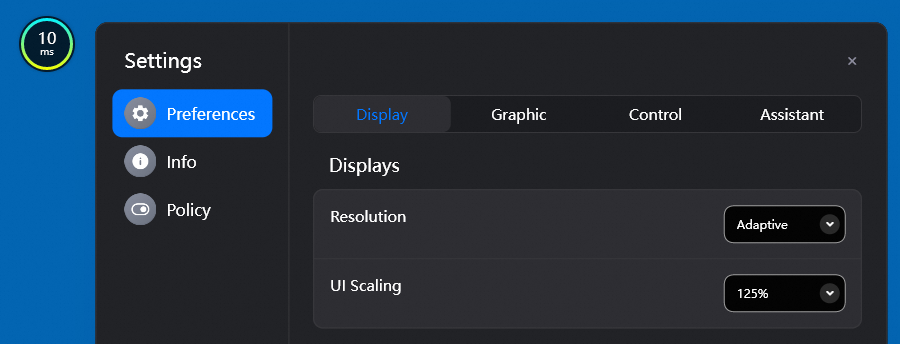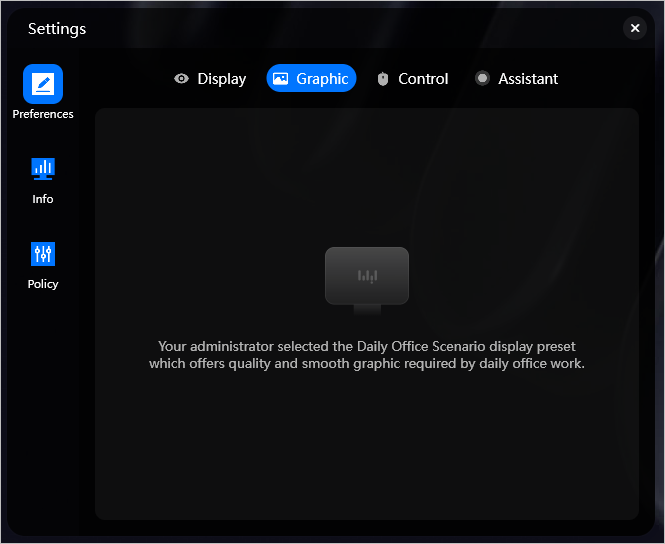After you connect to a cloud computer, you can click DesktopAssistant on the screen of the cloud computer and configure the preference settings for display, graphics, control, and DesktopAssistant based on your requirements. This topic describes how to configure the preference settings on a cloud computer.
In this topic, the Windows client of Alibaba Cloud Workspace V7.7 is used as an example. The actual use case may vary with the Alibaba Cloud Workspace client that you use. If the Workspace client you are using is outdated, update the client to the latest version.
How to access Preferences
To go to the Preferences interface, perform the following steps:
On the desktop of the cloud computer, click DesktopAssistant. In the menu that appears, click Settings.
In the left-side navigation pane of the Settings window, click Preferences.

Display preferences
Category | Parameter | Description |
Displays | Resolution | The display resolution of the cloud computer. The supported resolutions vary with the client type in use. Note
|
UI Scaling | If the application icons or text on the cloud computer are blurred or appear tiny due to a resolution discrepancy, configure the UI Scaling parameter based on your business requirements to scale the UI. | |
Other Settings | Media Redirection | If you want to use the pre-installed VideoLAN Client (VLC) video player on the cloud computer to play lossless and HD videos, we recommend that you enable Media Redirection. Note To enable Media Redirection, you must ask your administrator to enable the Media Redirection of Videos by Using VLC policy for the cloud computer in the Elastic Desktop Service (EDS) console. For more information, see Ensure the security of cloud computers. |
Cloud Computer Dual Displays | If an extended monitor is connected to the local computer, you can turn on Cloud Computer Dual Displays. When the cloud computer enters the full-screen mode, the dual-screen mode of the cloud computer follows the dual-screen display settings of the local computer. This setting takes effect only for the cloud computer on which the operation is performed. If you modify the setting, you must exit and re-enter the full-screen mode to allow the modification to take effect. |
Graphic preferences
If your administrator specifies the display mode in the policy associated with your cloud computer, the display mode applies to the display preference settings. You cannot change the settings. Make sure that the image of your cloud computer is V2.1.0 or later. For example, your administrator sets Display Mode to Daily Office Scenario in the EDS console, and then the display settings apply to your cloud computer.

If your administrator sets Display Mode to Manual, make sure that the image of your cloud computer is V2.1.0 or later. If the image of your cloud computer is earlier than V2.1.0, you can choose one of the following options on the Graphic tab:
Best Quality: The cloud computer supports up to 30 FPS and provides high graphic quality. You cannot change the maximum frame rate or graphic quality.
Best Performance: The cloud computer supports up to 60 FPS and provides medium graphic quality. You cannot change the maximum frame rate or graphic quality.
Intelligent: The cloud computer adjusts the frame rate and graphic quality according to the usage scenario, device, and network conditions.
Custom: You can customize the graphic quality parameters. A higher frame rate indicates better graphic quality but higher requirements on the local device and network. The real-time frame rate and graphic quality are dynamically adjusted based on the device and network conditions.
Maximum Frame Rate: the maximum number of frames that can be displayed on a monitor per second. A higher frame rate indicates smoother motion performance. Unit: FPS. Valid values: 10 to 60.
Highest Graphic Quality: the highest graphic quality of the cloud computer.
NoteThe graphic quality options depend on the graphic quality features that are enabled by your administrator. If the options provided fail to meet your requirements, contact your administrator to enable more graphic quality features.
Control preferences
Category | Parameter | Description |
Shortcut Keypress Handler | Windowed Mode | Specifies whether the cloud computer or the on-premises computer responds to the system shortcut keys and function keys (for example, F1 to F12) on the local keyboard device when the cloud computer is in the windowed mode. |
Fullscreen Mode | Specifies whether the cloud computer or the on-premises computer responds to the system shortcut keys and function keys (for example, F1 to F12) on the local keyboard device when the cloud computer is in the fullscreen mode. | |
Exit Fullscreen | The shortcut key that you want to use to exit the full-screen mode of the cloud computer. Default value: Note This parameter is available only when you use the Windows client of Alibaba Cloud Workspace. | |
Mouse Configuration | Confine Cursor | If you select the check box, your pointer is confined to the window of the cloud computer. This feature is suitable for 3D applications and gaming software. If you enable this feature, a full rotation action is guaranteed to occur when you change perspectives in a 3D game. After you enable this feature, you can configure a shortcut key or press the Esc key twice to temporarily disable pointer confinement, which allows the pointer to move out of the cloud computer window. Note This feature is available only if you use a Windows client of V5.0 or later and the cloud computer uses a GPU-accelerated image. |
DesktopAssistant preferences
Item | Description |
Alert information | Alerts on the usage of the cloud computer. You can enable or disable the alerts based on your requirements.
|
DesktopAssistant display content | The content displayed on and next to the DesktopAssistant icon. The battery percentage of the on-premises device: If you enable this information display, a circle indicator that displays the battery percentage of your on-premises device appears when you move the pointer over DesktopAssistant.
|
